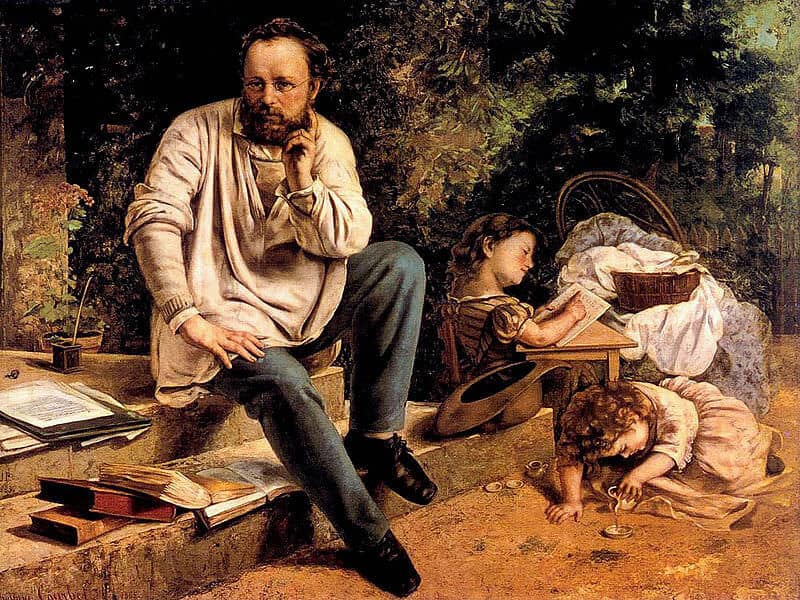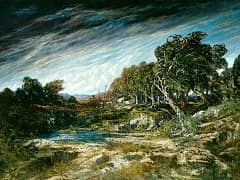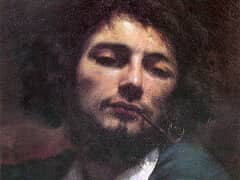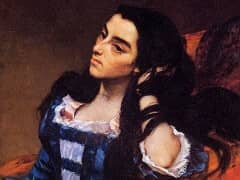Portrait of P.J. Proudhon, 1865 by Gustave Courbet

The death in January 1865 of the Socialist philosopher Proudhon moved Courbet to begin a painting in tribute to this fellow Franche-Comtois whom he had known and admired since his late twenties. To a mutual friend he wrote, "The nineteenth century has just lost its pilot and the man it has produced" - meaning its ideal man, its representative man. Proudhon's philosophy of democracy and human progress, developed out of the theories of Charles Fourier (himself a native of Besancon) and Saint Simon, were very important for the young Courbet in enabling him to work out a rationale for what he believed art should be and how it should relate to the life of its own time. Proudhon's anti-authoritarian and anti-clerical stance, together with the imprisonment and exile that he suffered as a result of his publications, aroused in Courbet the devotion of a disciple, which allowed him to overlook the writer's moralistic and indeed philistine views on art. Courbet had for many years wanted to paint a portrait of Proudhon, but the philosopher was an elusive and unwilling sitter. Thus he had to write from Ornans to his friend Castagnary in Paris, asking him to send him the photographs that had been made by Carjat and Reutlinger to use as models. In the letter he expressed his ambition to make a kind of monument for his mentor, so that:
all that life of work, of probity and of luminous thought will finally emerge in all its brilliance in the midst of the shadows that surround us, the end of the nineteenth century will have its beacon which will rise above the crowds . . .
Behind the rather grandiose language lay the genuine intention to make an important painting in the tradition of the "real allegory," which like The Meeting and The Painter's Studio would use actual persons known to the artist to embody a whole cluster of ideas. The life-sized figure is presented in a domestic setting, seated on the back steps of his modest house, accompanied by his two daughters. His workman's tunic and soft hat, together with his books and writing materials and his thoughtful gaze, are the signs of his character: the working-class artisan turned intellectual. Though Courbet's family was a generation ahead of Proudhon's in terms of class development, they were close enough so that the artist felt the identity, which was in turn that of the emerging class whom he had given artistic existence in his paintings of the fifties.
The intellectual portrayed here is not of the bohemian variety, but is rather the pere dejamilk. His two small daughters are shown playing with the opposing elements of their future: one with the alphabet, the other with teacups and pitcher. They are constructed in a way remarkably similar to that of Gericault's portrait of Louise Vernet: large heads on stubby bodies, capable of a disquieting concentration. The absent wife/mother is figured by the sewing basket and pile of linen on the empty chair. The painting as it was shown at the Salon of 1865 included the figure of Madame Proudhon, seated on the chair and obviously pregnant. Among other changes Courbet subsequently made to the painting was the removal of this figure, apparently in response to objections made by the widow herself. In either stage, whether the wife is depicted in the background entirely in terms of childbearing, or is completely absent from the picture, Courbet invented an accurate image of Proudhon's harshly patriarchal view of women. On the top step at the left is clearly inscribed "PJ.P/1853." Courbet may have chosen that year for at least two reasons: it was the year when one of Proudhon's important books, La philosophie du progres, was published (and banned); and it was a moment of domestic pride and contentment, with two children living and another on the way. The following year the middle child, shown playing with her cups, died of cholera.















